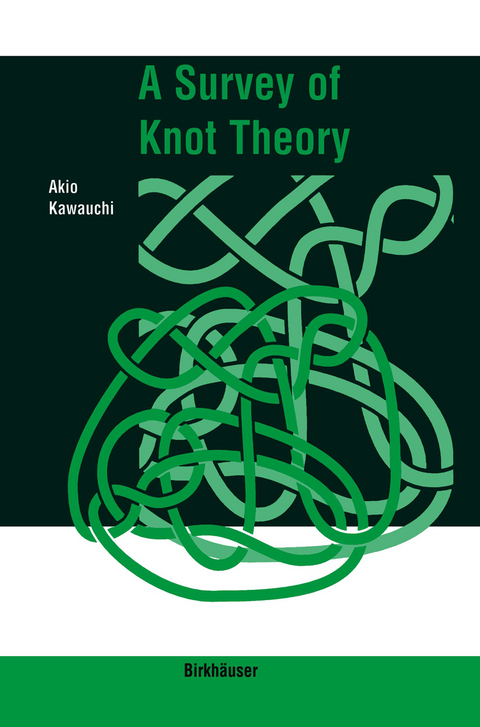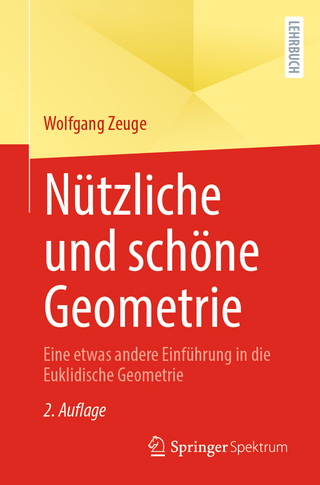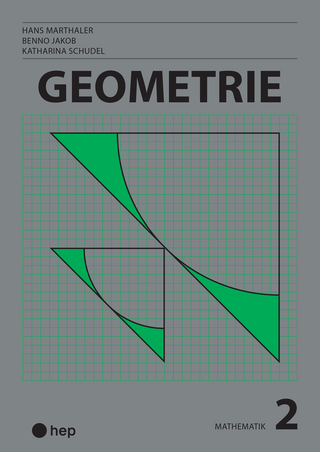
A Survey of Knot Theory
Springer Basel (Verlag)
978-3-0348-9953-6 (ISBN)
Knot theory is a rapidly developing field of research with many applications not only for mathematics. The present volume, written by a well-known specialist, gives a complete survey of knot theory from its very beginnings to today's most recent research results. The topics include Alexander polynomials, Jones type polynomials, and Vassiliev invariants. With its appendix containing many useful tables and an extended list of references with over 3,500 entries it is an indispensable book for everyone concerned with knot theory. The book can serve as an introduction to the field for advanced undergraduate and graduate students. Also researchers working in outside areas such as theoretical physics or molecular biology will benefit from this thorough study which is complemented by many exercises and examples.
0 Fundamentals of knot theory.- 0.1 Spaces.- 0.2 Manifolds and submanifolds.- 0.3 Knots and links.- Supplementary notes for Chapter 0.- 1 Presentations.- 1.1 Regular presentations.- 1.2 Braid presentations.- 1.3 Bridge presentations.- Supplementary notes for Chapter 1.- 2 Standard examples.- 2.1 Two-bridge links.- 2.2 Torus links.- 2.3 Pretzel links.- Supplementary notes for Chapter 2.- 3 Compositions and decompositions.- 3.1 Compositions of links.- 3.2 Decompositions of links.- 3.3 Definition of a tangle and examples.- 3.4 How to judge the non-splittability of a link.- 3.5 How to judge the primeness of a link.- 3.6 How to judge the hyperbolicity of a link.- 3.7 Non-triviality of a link.- 3.8 Conway mutation.- Supplementary notes for Chapter 3.- 4 Seifert surfaces I: a topological approach.- 4.1 Definition and existence of Seifert surfaces.- 4.2 The Murasugi sum.- 4.3 Sutured manifolds.- Supplementary notes for Chapter 4.- 5 Seifert surfaces II: an algebraic approach.- 5.1 The Seifert matrix.- 5.2 S-equivalence.- 5.3 Number-theoretic invariants.- 5.4 The reduced link module.- 5.5 The homology of a branched cyclic covering manifold.- Supplementary notes for Chapter 5.- 6 The fundamental group.- 6.1 Link groups and link group systems.- 6.2 Presentations of a link group.- 6.3 Subgroups and quotient groups of a link group.- Supplementary notes for Chapter 6.- 7 Multi-variable Alexander polynomials.- 7.1 The Alexander module.- 7.2 Invariants of a A-module.- 7.3 Graded Alexander polynomials.- 7.4 Torres conditions.- Supplementary notes for Chapter 7.- 8 Jones type polynomials I: a topological approach.- 8.1 The Jones polynomial.- 8.2 The skein polynomial.- 8.3 The Q and Kauffman polynomials.- 8.4 Properties of the polynomial invariants.- 8.5 The skein polynomial via a state model.- Supplementary notes for Chapter 8.- 9 Jones type polynomials II: an algebraic approach.- 9.1 Preliminaries from representation theory.- 9.2 Link invariants of trace type.- 9.3 The skein polynomial as a link invariant of trace type.- 9.4 The Temperley-Lieb algebra.- Supplementary notes for Chapter 9.- 10 Symmetries.- 10.1 Periodic knots.- 10.2 Freely periodic knots.- 10.3 Invertible knots.- 10.4 Amphicheiral knots.- 10.5 Symmetries of a hyperbolic knot.- 10.6 The symmetry group.- 10.7 Canonical decompositions and symmetry.- Supplementary notes for Chapter 10.- 11 Local transformations.- 11.1 Unknotting operations.- 11.2 Properties of X-Gordian distance.- 11.3 Properties of ?-Gordian distance.- 11.4 Properties of #-Gordian distance.- 11.5 Estimation of the X-unknotting number.- 11.6 Local transformations of links.- Supplementary notes for Chapter 11.- 12 Cobordisms.- 12.1 The knot cobordism group.- 12.2 The matrix cobordism group.- 12.3 Link cobordism.- Supplementary notes for Chapter 12.- 13 Two-knots I: a topological approach.- 13.1 A normal form.- 13.2 Constructing 2-knots.- 13.3 Seifert hypersurfaces.- 13.4 Exteriors of 2-knots.- 13.5 Cyclic covering spaces.- 13.6 The k-invariant.- 13.7 Ribbon presentations.- Supplementary notes for Chapter 13.- 14 Two-knots II: an algebraic approach.- 14.1 High-dimensional knot groups.- 14.2 Ribbon 2-knot groups.- 14.3 Torsion elements and the deficiency of 2-knot groups.- Supplementary notes for Chapter 14.- 15 Knot theory of spatial graphs.- 15.1 Topology of molecules.- 15.2 Uses of the notion of equivalence.- 15.3 Uses of the notion of neighborhood-equivalence.- Supplementary notes for Chapter 15.- 16 Vassiliev-Gusarov invariants.- 16.1 Vassiliev-Gusarov algebra.- 16.2 Vassiliev-Gusarov invariants and Jones typepolynomials.- 16.3 Kontsevich's iterated integral invariant.- 16.4 Numerical invariants not of Vassiliev-Gusarov type.- Supplementary notes for Chapter 16.- Appendix A The equivalence of several notions of "link equivalence".- Appendix B Covering spaces.- Appendix C Canonical decompositions of 3-manifolds.- Appendix D Heegaard splittings and Dehn surgery descriptions.- Appendix E The Blanchfield duality theorem.- Appendix F Tables of data.- References.
"The book...is in fact a small but feisty encyclopedia of the subject. It achieves its aim in a compact space by accurate statements of theorems and examples and by eschewing the details of the proofs of many theorems... A useful reference book that can serve as an introduction to many topics in the modern theory of knots."
--Bulletin of the AMS
| Erscheint lt. Verlag | 27.9.2011 |
|---|---|
| Zusatzinfo | XXI, 423 p. |
| Verlagsort | Basel |
| Sprache | englisch |
| Maße | 155 x 235 mm |
| Gewicht | 673 g |
| Themenwelt | Mathematik / Informatik ► Mathematik ► Geometrie / Topologie |
| Schlagworte | Algebra • fundamental group • Homology • Invariant • Knotentheorie • manifold • Mathematics • Theorem • Topologie • Topology • Variable |
| ISBN-10 | 3-0348-9953-X / 303489953X |
| ISBN-13 | 978-3-0348-9953-6 / 9783034899536 |
| Zustand | Neuware |
| Informationen gemäß Produktsicherheitsverordnung (GPSR) | |
| Haben Sie eine Frage zum Produkt? |
aus dem Bereich


